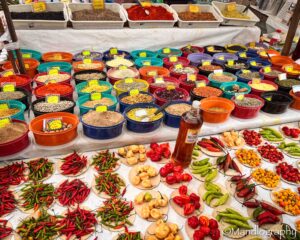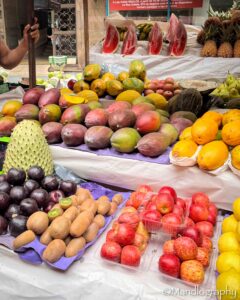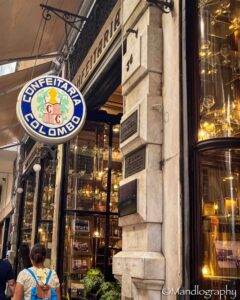 Brazil’s huge environmental diversity, results in a variation in the organic offerings of the land across the country, resulting in a wide variety of cuisines. As I was in Rio for just over a week, I decided to go on a food tour to get a bit more of an understanding of some of the options of food available in Brazil.
Brazil’s huge environmental diversity, results in a variation in the organic offerings of the land across the country, resulting in a wide variety of cuisines. As I was in Rio for just over a week, I decided to go on a food tour to get a bit more of an understanding of some of the options of food available in Brazil.
I booked a food tour in Rio on Viator with EatRio. The tour was hosted by Tom Le Mesurier, a British foodie who made his way to Latin America in 2009. He fell in love with Brazil and his interest in food led to an unravelling of new ingredients into his diet, with each trip to the market. He documented his discoveries on his food blog for years before his first ever food tour. He is very knowledgeable about his subject matter and has travelled extensively around Brazil to get a better understanding of Brazilian cuisine in different regions. If you find yourself booked onto this tour, I highly recommend you do not have a heavy meal beforehand, as everything is catered for and you can have more of anything you like during the tour, just remember to pace yourself. I went for the morning tour.
The tour started off at a fresh food market therefore the starting point of the tour differs depending on the day, as the local markets move around during the week. Fresh food markets offer a vibrant burst of colours and an opportunity to explore numerous unfamiliar ingredients.

We started off the tour by trying some Beiju de tapioca (sweet and savoury tapioca pancakes) which were deceitfully filling. The savoury one had queijo coalho cheese (brazillian cheese) and oregano while the sweet one had condensed milk and coconut. Walking down the market, we saw some of the biggest tropical fruits I had ever seen in my life. The guavas were the size of tennis balls with bright pink flesh. The dragon fruit, which has been described as one of the most disappointing fruit was a vibrant red with black spots. We spotted a wider variety of chillis, than I knew existed, at the market. They all apparently add different flavours to food. Wish I could have tried most of them. The market also had fresh meat and seafood on sale and as you got closer to those stalls, surprisingly the fishy smell was not offensive, as it seemed to all be kept fresh on ice.


There were so many fruits and vegetables and the stall owners were quite happy and friendly offering us fruits to try as we walked along. Cassava is quite a common ingredient in Brazilian cuisine and is available in various forms: whole, peeled and in water, cut into cubes in water, ground and dried to a powder as well as ground but still wet.
The tropical fruits included mangoes of varying sizes, paw paws, figs, pineapples, melons, guavas, passion fruit, all calling my name with some of the more localised fruits such as dragon fruit, persimmon, atemoya (from custard apple family), sour berries and other things. We had a chance to try each of these and found the flavours to vary from extremely sweet, to sour. We did this at a café where we also had some morning coffee/drinks. Before we left the market, we washed everything down with freshly squeezed sugar cane juice, which I discovered is more palatable with a squeeze of lime juice which breaks down the sweetness.

We then went to one of the oldest restaurants in Rio, Nova Capela, which opened in 1903. We were served a preselected menu of traditional Brazilian dishes including Bolinhos de bacalhau, (a deepfried salt cod and potato croquette), with chilli sauce on the side, Pastel de queijo (deep-fried pastry pocket filled with cheese), cabrito assado com batatas coradas, arroz brócolis e alhoa (a broccoli rice with roast potato and some slow cooked, then deep fried roasted lamb).

After that delightful and flavoursome meal, we were served a warm egg custard tart. Before leaving the restaurant, we had the pleasure of meeting one of the original owners of the restaurant who often came to the restaurant to ‘work’ as he believed once he stopped working, he would die. He was over a century years old.

As we continued our tour, to cool us down during a historic walk across the old city, we were able to order the local drink – caipirinha. I had mine with some black berries. Our walk eventually led us to the famous Selaron stairs, where Tom also shared tit bits about the artist and the creative scene in Rio. It really seems to be a hub where many different cultures are welcomed, celebrated and feel at home.


The tour then continued to a juice bar where we had a taster options which gave us an opportunity to try a range of new different juice combinations such as Avocado with orange juice, juice of the acerola berry and also some aged cachaca from the state of Ceará
By this point my stomach was full. However, there was one more stop, the Amazonian restaurant, which we were reliably informed is one of the only places in Rio that serves real fresh Acai, usually found in the Amazon forest. This is the pulp of the acai berry, slightly sweetened with guarana syrup. This can be enjoyed as is or mixed with desiccated coconut, granola or fruit. We also had the Suco de Cupuacu which is the juice of an Amazonian fruit that changes flavour as you drink it. This marked the end of the official tour.



A few of the people on the tour then decided to go to the famous bakery , Confeitario Colombo, that was founded in 1894 and featured in the Rio episode of the Netflix show ‘Somebody Feed Phil’. It was a beautiful bakery with beautiful historic architecture, which one could order treats to take away or sit down and eat. As my stomach was too full, I decided to order a few treats to take home to my friends.


Comment below if you would consider going on a food tour when you travel?



I was pretty pleased to uncover this website. I wanted to thank you for ones time for this wonderful read!! I definitely savored every part of it and I have you saved as a favorite to see new information on your site.